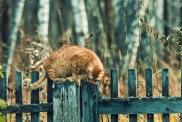The Himalayan cat is a long-haired breed who has a sweet temperament and striking appearance. They are a cross between Persian and Siamese cats and have the best qualities of both breeds. Himalayans have the dense, luxurious coat of a Persian and the distinctive colorpoint markings of a Siamese. Their eyes are always a brilliant blue, and their noses and paws are typically darker than the rest of their body.
Himalayans, also called Himmies, are generally gentle and affectionate cats. They are for good with children and other pets. Himalayans are also relatively low-maintenance cats but require regular grooming to prevent their coats from becoming matted.
Quick Facts
- Origin: The Himalayan cat is a breed that originated in the United States in the early 20th century. It is a crossbreed between Siamese and Persian cats.
- Size: Himalayan cats are medium to large-sized cats with a well-balanced and muscular body.
- Breed Group: Himalayans are a part of the Persian breed group, known for their long, luxurious coats and sweet personalities.
- Lifespan: 12 to 15 years.
- Coat: They have a long, silky coat that comes in various color points similar to Siamese cats. Their fur is typically cream or fawn with darker points on the ears, face, paws, and tail.
- Temperament: Himalayan cats are known for their gentle, calm, and affectionate nature. They are often described as quiet and enjoy lounging around the house. They can be quite social and enjoy the company of their owners.
- Exercise Needs: Himalayans are not particularly active cats and may be content with moderate exercise. Interactive toys and short play sessions can help keep them mentally and physically stimulated.
- Training: They are generally easy to litter train and can be taught basic commands. However, they may not be as active or outgoing as some other breeds, so training may require patience.
- Grooming: Their long fur requires regular grooming to prevent matting and tangles. Daily brushing is recommended to keep their coat in good condition. Additionally, regular eye cleaning may be necessary due to their flat faces, which can lead to tear staining.
- Health: Himalayan cats can be prone to some health issues common to flat-faced breeds, including respiratory problems and dental issues. They are also at risk for kidney disease and heart conditions. Regular vet check-ups are crucial to monitor their health.
- “Homeward Bound: The Incredible Journey” features a Himalayan cat named “Sassy” voiced by Sally Field.
Himalayan Cat Pictures
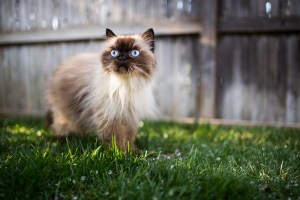
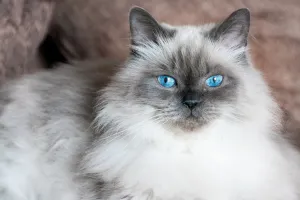
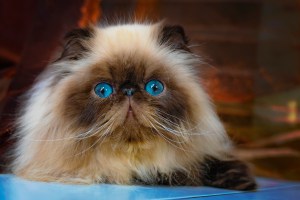
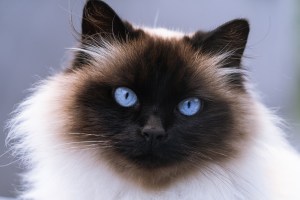
-
Affectionate with Family
Some cat breeds are typically independent and aloof, even if they’ve been raised by the same person since kittenhood; others bond closely to one person and are indifferent to everyone else; and some shower the whole family with affection. Breed isn’t the only factor that goes into affection levels; cats who were raised inside a home with people around feel more comfortable with humans and bond more easily.

See Cats Less Affectionate with Family -
Amount of Shedding
If you’re going to share your home with a cat, you’ll need to deal with some level of cat hair on your clothes and in your house. However, shedding does vary among the breeds. If you’re a neatnik, you’ll need to either pick a low-shedding breed or relax your standards. This furniture cover can make it easier to clean up cat hair and keep it off your sofa!
-
General Health
Due to poor breeding practices, some breeds are prone to certain genetic health problems. This doesn’t mean that every cat of that breed will develop those diseases; it just means that they’re at an increased risk. If you’re looking only for purebred cats or kittens, it’s a good idea to find out which genetic illnesses are common to the breed you’re interested in.
-
Potential for Playfulness
Some cats are perpetual kittens—full of energy and mischief—while others are more serious and sedate. Although a playful kitten sounds endearing, consider how many games of chase the mouse-toy you want to play each day, and whether you have kids or other animals who can stand in as playmates. A classic wand cat toy like this one is perfect for playful felines!
-
Kid-Friendly
Being tolerant of children, sturdy enough to handle the heavy-handed pets and hugs they can dish out, and having a nonchalant attitude toward running, screaming youngsters are all traits that make a kid-friendly cat. Our ratings are generalizations, and they’re not a guarantee of how any breed or individual cat will behave; cats from any breed can be good with children based on their past experiences and personality.
-
Friendly Toward Strangers
Stranger-friendly cats will greet guests with a curious glance or a playful approach; others are shy or indifferent, perhaps even hiding under furniture or skedaddling to another room. However, no matter what the breed, a cat who was exposed to lots of different types, ages, sizes, and shapes of people as a kitten will respond better to strangers as an adult.
-
Easy to Groom
Some breeds require very little in the way of grooming; others require regular brushing to stay clean and healthy. Consider whether you have the time and patience for a cat who needs daily brushing. You should definitely pick up this awesome de-shedding tool for cats of any hair length!
-
Pet Friendly
Friendliness toward other household animals and friendliness toward humans are two completely different things. Some cats are more likely than others to be accepting of other pets in the home.
Himalayan History
The Himalayan cat, also known as the Himmie, is a man-made breed developed by crossing Persians with Siamese to bring in the color points and blue eyes of the Siamese.
Breeders began to work towards this goal in 1931 when cat breeder Virginia Cobb and Harvard Medical School researcher Clyde Keeler started selective breeding to develop longhaired cats with the distinctive color points of the Siamese. The first kitten to be called a Himalayan was named Newton’s Debutante.
In the 1950s, British and North American breeders became interested in achieving a Siamese-pointed Persian. They started with the Cobb-Keeler “recipe” to get the colorpoint pattern and then bred the cats back to Persians to establish breed type. Once the cats bred true, they sought recognition as a breed.
Whether the Himalayan is considered a variety of Persian or a distinct breed depends on which cat association you talk to. The Cat Fanciers Association recognized the Himalayan as a distinct breed in 1957, but in 1984 the CFA Board of Directors decided to reclassify the Himalayan as a color variety of the Persian.
The American Cat Association also considers the Himalayan a color variety of the Persian, and The International Cat Association recognizes the Himmie as a member of its “Persian Group,” which includes the Persian and the Exotic Shorthair. In other registries, including the American Association of Cat Enthusiasts, the American Cat Fanciers Association, and the Traditional Cat Association, the Himalayan is classified separately from the Persian.
Himalayans may be outcrossed to Persians or, in some associations, Exotic Shorthairs, but the Siamese is no longer a part of the Himalayan breeding program. And today, no matter what he’s called, the Himmie is among the most popular pedigreed cats.
Himalayan Size
Himalayan cats are a medium to large-sized breed. On average, they typically weigh between 7 to 12 pounds (3.2 to 5.4 kg) and stand about 9 to 10 inches (23 to 25 cm) tall at the shoulder. Their size can vary slightly based on gender, genetics, and individual differences, but they are generally known for their sturdy build and luxurious, long fur.
Himalayan Personality
Himalayan cats are known for their gentle, affectionate, and docile personalities. They are often described as being “lap cats” because they love to cuddle and be petted. Himalayans are also relatively quiet cats, and they are not known for being overly active. They are content to relax on their owners’ laps or follow them around the house.
Here are some of the key personality traits of Himalayan cats:
- Affectionate: Himalayans are very loving and cuddly cats. They love to be petted and scratched, and they will often follow their owners around the house just to be close to them.
- Docile: Himalayans are gentle and easygoing cats. They are not known for being aggressive or destructive, and they are generally good with children and other pets.
- Quiet: Himalayans are relatively quiet cats. They do not meow often, and they are not known for being noisy or disruptive.
- Loyal: Himalayans are very loyal cats. They form strong bonds with their owners, and they will often follow them around the house just to be close to them.
- Intelligent: Himalayans are intelligent cats. They are easy to train, and they can learn simple tricks.
If you are looking for a loving, affectionate, and docile cat, then the Himalayan may be the perfect breed for you. They are relatively low-maintenance cats, but they do require regular grooming. With proper care, Himalayans can live long and happy lives.
Here are some additional facts about Himalayan cats:
- They were first bred in the United States in the 1930s.
- The name “Himalayan” comes from the fact that their colorpoint markings are similar to those of the snow leopard, which is found in the Himalayas.
- Himalayans are one of the most popular cat breeds in the world.
- They are often used as therapy cats because they are so gentle and loving.
Himalayan Health
Both pedigreed cats and mixed-breed cats have varying incidences of health problems that may be genetic in nature. Although they are beautiful and sweet, Exotics are prone to a number of potential health problems, most commonly related to their facial structure:
- Breathing difficulty or noisy breathing caused by constricted nostrils
- Dental malocclusions, meaning the teeth don’t mesh well together
- Excessive tearing
- Eye conditions such as cherry eye, entropion and progressive retinal atrophy
- Feline hyperesthesia syndrome, a nervous system disorder
- Heat sensitivity
- Polycystic kidney disease, for which a genetic test is available
- Predisposition to ringworm, a fungal infection
- Seborrhea oleosa, a skin condition that causes itchiness, redness and hair loss
Himalayan Care
The most important thing to understand about caring for a Himalayan cat is that they require daily grooming. Their long, beautiful coat does not stay clean and tangle-free on its own. It must be gently but thoroughly combed every day, and regular bathing (at least once a month) is a good idea.
Another factor to consider is the litter box issue. Litter may become lodged in a Himalayan’s paws or coat. If the cat and the litter box are not kept scrupulously clean, a Himmie is more likely than most to just stop using the box.
Excessive tearing can be a problem in this breed, so wipe the corners of the eyes clean daily to prevent under-eye stains from forming. Brush the teeth to prevent periodontal disease. Daily dental hygiene is best, but weekly brushing is better than nothing.
It is a good idea to keep a Himalayan cat as an indoor-only cat. They are not scrappers and would fare poorly against other cats, dogs, coyotes, and the other dangers that face cats who go outdoors. Himalayans who go outdoors also run the risk of being stolen by someone who would like to have such a beautiful cat without paying for it.
Himalayan Coat Color And Grooming
The Himalayan cat shares the Persian’s sweet expression and soft round lines. It has a large, round head; large, round eyes; a short nose; full cheeks; and small ears with rounded tips. The head is supported by a short, thick neck and a deceptively sturdy, muscular body. Its legs are short, thick, and strong with large, round, firm paws. The tail is short but proportional to the length of the cat’s body.
A Himalayan’s coat is long, thick, shiny, and fine-textured. It is long all over the body and includes an immense ruff around the neck, a deep frill between the front legs, long ear and toe tufts, and a full “brush,” or tail.
The Himalayan is bred in the following point colors: chocolate, seal, lilac, blue, red, cream tortie, blue-cream, chocolate-tortie, lilac-cream, seal lynx, blue lynx, red lynx, cream lynx, tortie lynx, blue-cream lynx, chocolate lynx, lilac lynx, chocolate-tortie lynx, and lilac-cream lynx. The body is various shades of white to fawn with color only on the facial mask and the feet, ears, and tail.
Unlike the Persian and the Exotic, the Himalayan’s eyes come in only one color: a deep, vivid blue.
Himalayans come in two different “looks,” known as extreme and traditional. Extreme Himalayans, those seen in the show ring, have a flatter face, which may come with breathing problems. Cats with the traditional look have a more old-fashioned appearance, with a face that is not as flat and a nose that is set lower on the face with more of a “break,” permitting easier breathing. They are registered by the Traditional Cat Association.
Children And Other Pets
Himalayan cats are not the best choice for a houseful of boisterous children and dogs. They are gentle and docile cats who prefer a quiet and serene environment. However, they do not mind being the object of gentle attention from children, as long as the children are respectful of the cat’s boundaries.
If you have children, it is important to teach them how to interact with a Himalayan cat in a way that is safe and comfortable for both the cat and the child. For example, children should be taught to avoid pulling the cat’s tail or ears, and they should not try to pick up the cat unless the cat is clearly comfortable with being picked up.
Himalayan cats can also get along well with friendly dogs, as long as the dog is not aggressive or overly playful. If you have a dog, it is important to introduce the dog to the cat slowly and carefully, and to supervise their interactions closely at first.
Here are some tips for introducing a Himalayan cat to a child or dog:
- Start by letting the cat and the child or dog sniff each other through a closed door.
- Once they seem comfortable with each other’s scent, you can open the door and let them see each other.
- Supervise their interactions closely at first, and intervene if either the cat or the child or dog seems to be getting stressed or uncomfortable.
- With patience and positive reinforcement, most Himalayan cats and children or dogs can learn to get along well.
If you are considering getting a Himalayan cat, it is important to think about your lifestyle and your family’s needs. If you have young children or a lot of noise and activity in your home, a Himalayan cat may not be the best fit for you. However, if you are looking for a gentle and loving companion who enjoys being around people, a Himalayan cat could be the perfect pet for you.
Himalayan Rescue Groups
More Info For You
If you’re also looking for a dog, please visit DogTime’s dog breed page!





